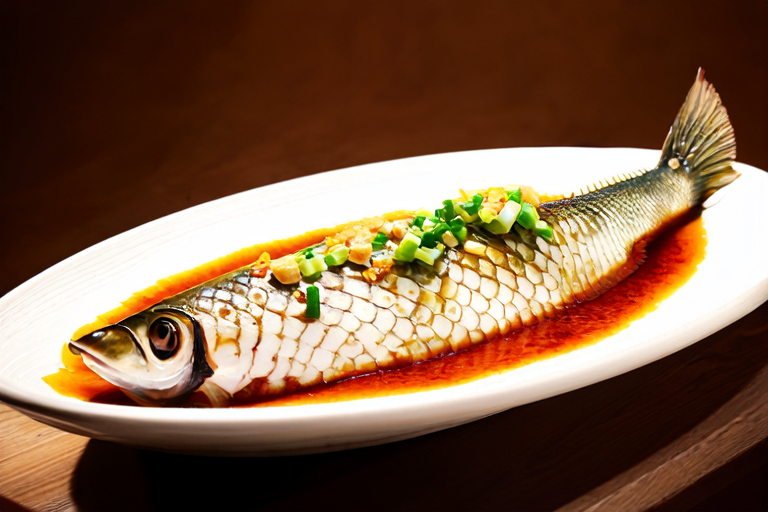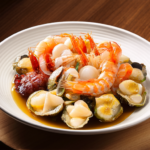- Introduction to Classic Cantonese Steamed Sea Bass with Ginger and Scallion
Cantonese cuisine is renowned for its delicate flavors and meticulous preparation techniques. Among the myriad of dishes that exemplify this culinary tradition, steamed sea bass with ginger and scallion stands out as a quintessential offering. This dish, known as Braised Sea Bass with Ginger and Scallion in Cantonese, or 清蒸海鲈鱼 (Qīng Zhēng Hǎi Lú Yú) in Mandarin, is not only a testament to the artistry of Cantonese cooking but also a celebration of the natural flavors of fresh ingredients. The simplicity of the dish belies its complexity; it is a harmonious blend of subtle sweetness from the fish, the pungency of ginger, and the freshness of scallions. In this article, we will explore the history, preparation methods, and cultural significance of this beloved classic.
- The History and Cultural Significance
The origins of steamed sea bass with ginger and scallion can be traced back to the ancient port cities of Guangdong province, where seafood was abundant and highly prized. Fish, particularly sea bass, has long been a symbol of prosperity and good fortune in Chinese culture. The method of steaming fish, which preserves its delicate texture and enhances its natural flavors, is a hallmark of Cantonese cooking. Over time, this dish has become an integral part of both formal banquets and everyday meals, reflecting the enduring appeal of Cantonese cuisine.
In Cantonese culture, the presentation of food is just as important as its taste. Steamed sea bass with ginger and scallion is often served whole, with the head and tail intact, symbolizing unity and completeness. The dish is typically garnished with a scattering of chopped scallions and ginger, adding a visual element that complements its exquisite flavor profile. Additionally, the use of ginger and scallion in this dish serves not only as a seasoning but also as a digestive aid, aligning with traditional Chinese medicine principles.
- Selecting the Right Ingredients
To prepare a truly authentic and delicious version of this dish, selecting the right ingredients is paramount. The quality of the sea bass plays a crucial role in determining the success of the dish. Look for a firm, shiny fish with clear eyes and bright gills. Freshness is key, so try to purchase your fish from a reputable source or a market that offers freshly caught seafood. If possible, opt for a whole sea bass, as it not only looks impressive but also ensures even cooking throughout the fish.
For the aromatics, choose fresh ginger and scallions. The ginger should have a robust, slightly spicy aroma, while the scallions should be crisp and green. Both ingredients should be free from any signs of wilting or browning. Additionally, consider using a small amount of soy sauce, sesame oil, and rice wine to enhance the flavor of the dish. These condiments should be of high quality to ensure that they do not overpower the natural taste of the fish.
- Preparing the Ingredients
Once you have gathered all the necessary ingredients, it’s time to prepare them for cooking. Start by cleaning the sea bass thoroughly. Remove any scales, guts, and blood vessels. Rinse the fish under cold water and pat it dry with paper towels. This step is essential to ensure that the fish steams evenly and retains its moisture during cooking.
Next, prepare the ginger and scallions. Slice the ginger into thin strips and finely chop the scallions. You can also julienne some of the scallions for added texture. Set these aside until you’re ready to assemble the dish. It’s important to note that the ginger and scallions should be cut into uniform pieces to ensure even cooking and distribution of flavors.
Prepare a marinade for the fish. In a small bowl, mix together a tablespoon of soy sauce, a teaspoon of sesame oil, and a splash of rice wine. This simple marinade will help enhance the natural flavors of the fish without overwhelming them. Gently rub this mixture over the surface of the fish, making sure to coat it evenly. Let the fish marinate for about 10 minutes to allow the flavors to penetrate the flesh.
- Cooking the Dish
Now comes the most critical part: cooking the sea bass. Begin by bringing a pot of water to a boil on the stovetop. Once the water is boiling, place a heatproof plate or rack inside the pot to create a platform for the fish. Carefully place the marinated sea bass onto the plate or rack, ensuring that it sits level and does not touch the sides of the pot.
Steam the fish for approximately 8-10 minutes, depending on its size. To check if the fish is done, gently insert a skewer into the thickest part of the fish. If the skewer comes out clean, the fish is ready. Overcooking can lead to a dry and tough texture, so it’s essential to monitor the fish closely. Once the fish is cooked, remove it from the pot and let it rest for a few minutes before serving.
While the fish is steaming, prepare the final touches. In a small pan, heat a tablespoon of oil over medium heat. Add the sliced ginger and sauté for about 30 seconds until fragrant. Pour this mixture over the steamed fish. Garnish with the chopped scallions and a drizzle of soy sauce and sesame oil. The combination of the hot oil and the raw aromatics creates a burst of flavor that complements the delicate texture of the fish.
- Serving Suggestions
Steamed sea bass with ginger and scallion is traditionally served as part of a larger meal, often accompanied by steamed vegetables such as bok choy or broccoli. The lightness of the fish pairs beautifully with the crispness of the vegetables, creating a well-balanced dish. Additionally, a bowl of plain rice can serve as a perfect accompaniment, allowing diners to savor every bite of the fish without overwhelming its delicate flavors.
For those who prefer a bit more flavor, you can serve the dish with a side of pickled vegetables or a mild dipping sauce made from soy sauce, vinegar, and a touch of sugar. These additions provide a contrasting taste that enhances the overall dining experience without detracting from the purity of the fish.
- Variations and Adaptations
While the traditional preparation of steamed sea bass with ginger and scallion is highly regarded, there are numerous variations that can be adapted to suit different tastes and dietary preferences. For instance, you can substitute sea bass with other types of white-fleshed fish, such as snapper or cod, to achieve similar results. Additionally, incorporating other aromatics like garlic, chili, or cilantro can add depth and complexity to the dish.
For a healthier twist, you can reduce the amount of oil used in the final preparation or omit it altogether. Instead, rely solely on the natural flavors of the fish and the fresh ginger and scallions. This approach emphasizes the purity of the ingredients and promotes a lighter, more health-conscious version of the dish.
- Conclusion
Steamed sea bass with ginger and scallion is a timeless classic in Cantonese cuisine, celebrated for its simplicity and elegance. By carefully selecting fresh ingredients, preparing them meticulously, and cooking the fish to perfection, you can recreate this dish in your own kitchen and enjoy a true taste of Cantonese culinary artistry. Whether you’re hosting a special dinner or simply looking for a comforting meal, this dish is sure to impress and delight your guests. Embrace the tradition, savor the flavors, and appreciate the harmony of ingredients that make this dish a true masterpiece of Cantonese cooking.


